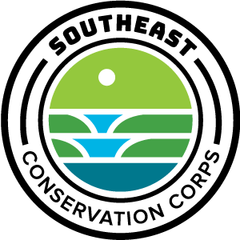Boardwalks and Barbeques at Natchez Trace
BlogJuly 22, 2021 | For our first full hitch of the season, my crew went to Tupelo, Mississippi to do trail work along the Natchez Trace Parkway. We worked on multiple projects, including replacing decking on a boardwalk, removing brush from trails, and replacing a bridge that was falling apart. We spent the most time on the boardwalk, replacing 274 boards in total and getting lots of mosquito bites in the process. Two highlights of the week were going out for barbecue together for the Fourth of July and receiving lots of gratitude from people using the boardwalk while we worked on it.
The bridge replacement project was especially interesting for me because of the ecological reasoning behind it. Our project partner wanted to use native timber to form the base of the new bridge, so we helped him by removing the bark from the trees that would be used. The trees we used were eastern redcedars (Juniperus virginiana), a type of juniper that grows throughout the eastern U.S. In the Blackland prairie habitat near the Natchez Trace, fire suppression has enabled the junipers to grow densely, blocking light from reaching the forest floor. The park is working on removing the junipers and reintroducing fire to restore the prairie. Most of the Blackland prairie has been converted to farmland, so it is important to protect the patches of the unique ecosystem that remain.

The difference between the side of the trail where the prairie has been restored with prescribed burns and the side with the dense junipers was striking. Almost nothing grows under the trees, but the prairie was full of a diverse mix of grasses and wildflowers. Removing the three junipers for the bridge will allow more light to reach the ground, letting more plants grow. I love learning about ecological restoration, so getting to play a part in this project was exciting.
Rosa Kirk- Davidoff
Crew #988




